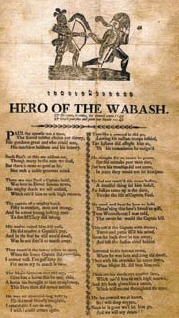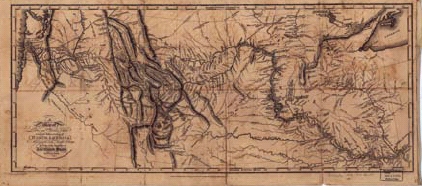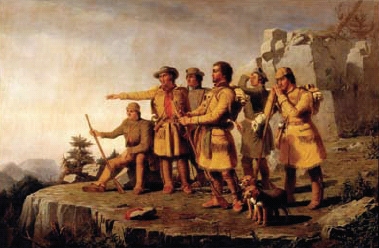The Filson Institute Academic Conference: Comparative Perspectives on North American Borderlands
By A. Glenn Crothers
The Filson Institute,
Director of Research
About |
 On October 20-21, 2006 The Filson Historical Society will host the Filson Institute’s second academic conference. The academic conferences are committed to bringing together historians and the general public in a congenial setting to explore cutting-edge themes and issues in the historical scholarship.
On October 20-21, 2006 The Filson Historical Society will host the Filson Institute’s second academic conference. The academic conferences are committed to bringing together historians and the general public in a congenial setting to explore cutting-edge themes and issues in the historical scholarship.
The May 2003 conference, in which I participated as a commentator, explored the nature of regionalism in the Ohio River Valley, seeking to understand how the Valley’s historical role as a borderland resulted in a contested and conflicted region of shifting loyalties and identities.
The October 2006 conference will expand the examination of borderlands by comparing the historical experience of the Ohio Valley to that of North America’s southern and northern borderlands before 1860. These regions, like the Ohio Valley, were during various portions of their history contested, with no particular group exercising political, cultural or economic dominion. The forthcoming conference, then, will explore common historical themes and issues related to the interaction of peoples and cultures throughout North America, including the Ohio River Valley, the Spanish borderlands from Florida to California, and the northern boundaries between the French and English empires. The mixing and clashing of peoples and cultures in these regions—American Indians, African Americans, Spanish, French, American, and English—provides a rich opportunity to understand both the ways in which regional factors shaped and altered the interaction of cultures, peoples and empires, and to examine the common themes arising from all such cultural and imperial contact.
The conference conveners, Andrew
Cayton of Miami University
of Ohio and David J. Weber of
Southern Methodist University, are
both leading scholars of American
borderlands. Cayton’s histories
of frontier Indiana and Ohio are
the best of their kind; his most
recent book, The Center of a Great Empire, is an edited collection of
essays exploring the Ohio Country
in the early republic. Weber’s The
Spanish Frontier in North America is
a magisterial study of the Spanish
in North America that has
become a standard  reference tool
for historians. Their enthusiasm
and knowledge have been invaluable
in helping to put together this
conference. They played a crucial
role in evaluating the sixty-plus
paper proposals we received in response
to the initial call for papers,
and in organizing the accepted
papers into thematically coherent
sessions. Ultimately, we accepted
eighteen proposals organized into
six themes: Spiritual Borderlands,
Racial Borderlands, Violent Borderlands,
Imposed Borderlands,
Political Borderlands, and Ethnic
Borderlands. We are particularly
excited by the mix of established
and nationally-prominent scholars,
young and promising graduate
students, and independent scholars
who submitted applications
and will be part of the conference.
Cayton and Weber will also provide
opening and closing remarks.
reference tool
for historians. Their enthusiasm
and knowledge have been invaluable
in helping to put together this
conference. They played a crucial
role in evaluating the sixty-plus
paper proposals we received in response
to the initial call for papers,
and in organizing the accepted
papers into thematically coherent
sessions. Ultimately, we accepted
eighteen proposals organized into
six themes: Spiritual Borderlands,
Racial Borderlands, Violent Borderlands,
Imposed Borderlands,
Political Borderlands, and Ethnic
Borderlands. We are particularly
excited by the mix of established
and nationally-prominent scholars,
young and promising graduate
students, and independent scholars
who submitted applications
and will be part of the conference.
Cayton and Weber will also provide
opening and closing remarks.
One of the most important parts of academic history conferences are the remarks of commentators. In this regard, the October borderlands conference promises to be an engaging event. Commentators include Christine Heyrman, professor of history at the University of Delaware and author of Southern Cross, a seminal examination of early national southern evangelicalism; Stephen Aron, who runs the Autry National Center and teaches at UCLA, and whose How the West Was Lost remains the best study of frontier Kentucky; and Daniel Usner, professor of history at Vanderbilt University and author of Indians, Settlers, and Slaves in a Frontier Exchange Economy, which helped redefine historians’ understanding of the early frontier. Other commentators include Jane Landers, who like Usner teaches at Vanderbilt, and has written widely about the African American community of colonial Florida; Wayne Lee, formerly at the University of Louisville and in August 2006 at the University of North Carolina Chapel Hill, whose Crowds and Soldiers in Revolutionary North Carolina marks an important rethinking of the uses and limits of violence in early America; and Andrew Frank, of Florida Atlantic University. His recent study of the Creek Indians, Creeks and Southerners, explores the cultural and ethnic mixing that was a defining feature of North America’s borderlands.
 The October conference promises
to be an exciting and engaging
experience for both participants
and audience, and to make an
important contribution to the
growing body of borderland
scholarship. Most important, the
conference provides the opportunity
for scholars and the interested
public to understand the common
themes that link the Ohio Valley
and North America’s southern and
northern borderlands. To encourage
a fuller exchange of ideas, the
papers will be posted on-line in
the weeks before the conference.
Ultimately, the best of the papers
will be published so that those
who are unable to attend can
participate in this important and
ongoing scholarly dialogue.
The October conference promises
to be an exciting and engaging
experience for both participants
and audience, and to make an
important contribution to the
growing body of borderland
scholarship. Most important, the
conference provides the opportunity
for scholars and the interested
public to understand the common
themes that link the Ohio Valley
and North America’s southern and
northern borderlands. To encourage
a fuller exchange of ideas, the
papers will be posted on-line in
the weeks before the conference.
Ultimately, the best of the papers
will be published so that those
who are unable to attend can
participate in this important and
ongoing scholarly dialogue.
For a schedule of this event, please click here.
The Filson Historical Society
1310 South Third Street - Louisville, KY 40208
Phone: (502) 635-5083 Fax: (502) 635-5086
Hours
The Ferguson Mansion and Office
Monday - Friday: 9 am. - 5 pm.
Saturday and Sunday closed
Library
Monday - Friday: 9 am. - 5 pm.
Saturday: 9 am. - 12 noon
